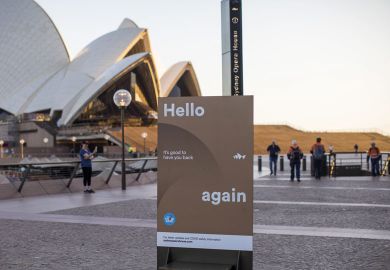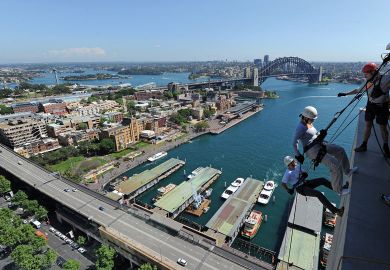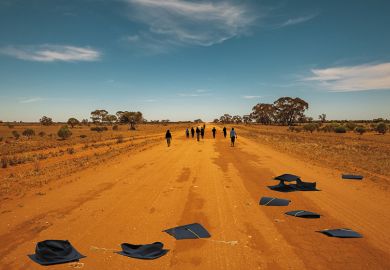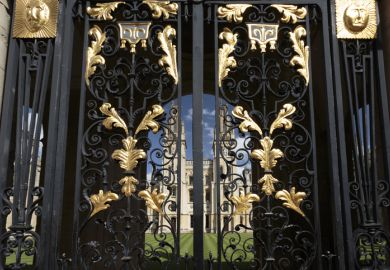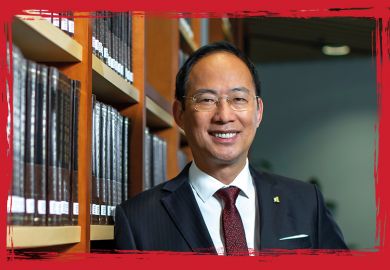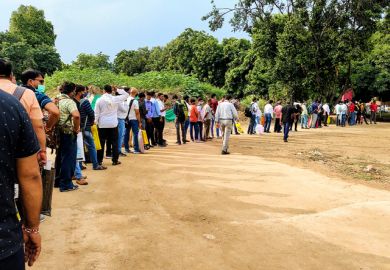Fewer Australians started degrees during the third year of the coronavirus pandemic than at any other time over the previous decade, while completion rates slumped to their lowest level on record.
As Canberra considers reforms to make university enrolments more inclusive and abundant, the latest available statistics show that many key indicators are moving in the opposite direction.
The number of commencing domestic undergraduate students in 2022 was the lowest since 2013, down 8 per cent from the previous year and 3 per cent from pre-pandemic levels, according to federal Department of Education data.
Enrolments fell during 2022 in every broad field of study, including areas of worker shortage such as engineering, information technology and teaching. Some disciplines experienced more sustained declines, attracting fewer students than before the pandemic.
They included areas saddled with tuition fee increases under the previous government’s Job-ready Graduates reforms, such as management, the humanities and the creative arts, but also fields of supposed labour force demand like nursing and science.
New enrolments from under-represented groups also decreased, with declines in every equity group apart from students with disabilities. “This may be the ongoing impact of a definitional change in disability rolled out in 2020,” a summary report notes.
Indigenous enrolments fell for the first time in at least 16 years, while domestic commencements from regional and economically deprived areas sank to their lowest level in at least six years.
Students from the poorest quartile of neighbourhoods comprised 16 per cent of domestic undergraduate enrolments in 2022, down from 17 per cent before the pandemic.
Boosting equity enrolments has been a central policy objective of the education minister, Jason Clare, and the Australian Universities Accord panel he appointed in late 2022.
Chair Mary O’Kane said her panel’s final report, which was handed to Mr Clare three days after Christmas, contained 47 recommendations. “Each goes to the review’s vision of a stronger Australia…that is highly skilled, productive, equitable and knowledgeable,” she said.
Australian National University policy expert Andrew Norton said the decrease in new domestic undergraduate enrolments more than doubled the previous largest slump in 2003, when then-minister Brendan Nelson cracked down on universities that were exceeding their admissions quotas.
But Professor Norton said the decline among school-leavers appeared to be “a correction back to pre-Covid levels” rather than a major disruption.
“In 2021 school-leavers could not take gap years so started university earlier than planned, or decided to sit out a recession at university,” he blogged. “In 2022 gap years were back.” But enrolment patterns among older students are “more volatile”, he added.
Campus resource collection: Pathways to better university admissions
Tertiary education analyst Ant Bagshaw said the “turnaround” in higher education participation was “not a peculiarly Australian disease”, with similar trends evident in New Zealand and the UK. Such downturns could not be attributed exclusively to high employment or after-effects of the coronavirus pandemic, as cost-of-living pressures had fostered scepticism about the value of higher education.
“The calculation has changed. Rent is horrendous; food prices, energy, travel, all of that. While the cost of university itself has remained static, that’s not happening in isolation. Every piece of evidence points to this being quite a deep recession. We have to assume that this is a problem, because all the projections for the future economy and labour market say that we need more people with higher qualifications.”
But he noted that the most technologically advanced economies, such as Singapore and South Korea, already had higher participation rates than Australia’s. “We’re not at the top of the participation curve globally, so I think we’re still going up in the longer term. I remain convinced that the long-term trend of increasing participation will hold, and that this will be a blip.”
Cost pressures are pushing more students out of university as well as preventing them from enrolling in the first place, the Education Department figures suggest. The proportion of first-year undergraduates who failed to return the following year rose by 2 percentage points to 15 per cent, and reached 25 per cent in several regional universities with large shares of mature-aged students.
Just 41 per cent of bachelor’s students had completed their degrees within four years, and 62 per cent within six years. “This is the lowest recorded six-year completion rate,” the summary report notes.
It says the proportion of undergraduates studying less than a full-time load increased from 44 per cent in 2018 to 47 per cent in 2022. Twenty-two per cent had dropped out completely within four years, and 25 per cent within six years.
Register to continue
Why register?
- Registration is free and only takes a moment
- Once registered, you can read 3 articles a month
- Sign up for our newsletter
Subscribe
Or subscribe for unlimited access to:
- Unlimited access to news, views, insights & reviews
- Digital editions
- Digital access to THE’s university and college rankings analysis
Already registered or a current subscriber? Login

